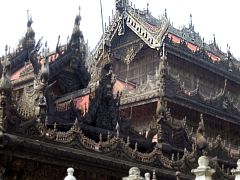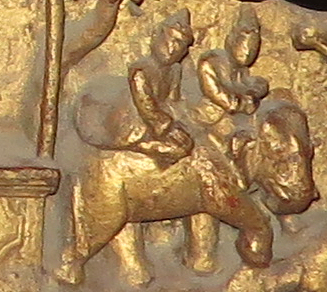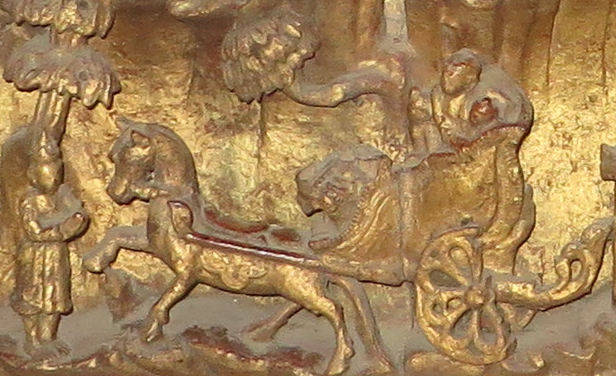
The Golden Monastery of Mandalay, in central Myanmar, a former royal palace. The illustrations on this page are from a gilt-on-wood sculpture in the monastery.
Content created: 2014-03-25
File last modified:

It is widely believed by Buddhists that, in each of his previous incarnations, the karmic entity that was to become Siddhartha Gautama, the historical Buddha, gained more and more karmic merit. After his enlightenment, the Buddha is said to have recounted 547 stories in response to questions about his previous incarnations, and thus about the ways in which people could follow his example.
(Most Buddhists also believe that many buddhas preceded Siddhartha Gautama and many will follow him. They are different people, each with his or her own previous incarnations, different from the pre-incarnations of Siddhartha Gautama.)
The stories of Siddhartha’s previous lives are referred to as Jātaka (“nativity”) tales, and 547 of them make up perhaps the most widely popular part of the Pali Buddhist text tradition. (There are additional such stories outside of this corpus.)
In recent centuries, well known Jataka tales, singularly or as a group, have frequently been used as murals on the interior and exterior walls of temples across southeast Asia.
“A tradition of depicting the final ten jātakas as a coherent group dates back to around the eleventh century in Mon temples of Lower Burma. In Thailand the earliest surviving temple murals of the ten jātakas are from the end of the seventeenth or beginning of the eighteenth century … .” (Appleton et al. p. 14)
The ten stories are named after their protagonist bodhisattvas. Their names and the particular virtue each manifested are:
The historical Buddha’s final incarnation before he became Siddhartha Gautama illustrates the virtue of generosity (dāna). According to the Jataka tradition, in that life he was a prince named Vessantara (Viśvantara or Viśvaṃtarā in Sanskrit, Xūdàná 须大拏 in Chinese).

This popular story, in various versions is often painted on long rolls of cotton cloth and carried in processions in the borderland of Thailand and Laos during a winter festival called Bun Phra Wet. One such scroll made its way into the Asian Civilizations Museum in Singapore, which has published a fascinating volume containing a reproduction with a full translation into English and standard Thai, together with chapters on the art and ethnography of such scrolls. That book provides the basis for my summary retelling of the story here, although the proper names have been converted into more standard Pali, following Buswell and Lopez. (Sources are listed after the story.)
The generosity manifested in this story is mythic, not realistic. If it offends modern sensibilities, at least for English speakers, it is well to keep in mind the Vessantara’s status as an icon of superhuman generosity, not a realistic representation of it.
Perhaps more striking is the representation of Brahmins. Buddhism can be interpreted as having arisen as one of many movements reacting against the Vedic ceremonialism and the associated privileges of the Brahmin caste. Caste is not a particularly important consideration in most of the Buddhist world today, but it is interesting to see how in this story, so wildly popular across southeast Asia, Brahmins are nevertheless portrayed as uniquely villainous. Just as the “Romans” in Mexican morality plays are mere symbols of oppression and have nothing but costumes in common with real Romans, so the Brahmins in the Jatakas are symbols of human vice and foils for the generosity of Vessantara, but have lost any resemblance to real Brahmins. A good folk tale, it seems, needs a good villain.
Once upon a time in the kingdom of Sivirattha (Siviraṭa) , there reigned a king named Sanjaya and his wife Phusati, and they lived in a beautiful palace in the city of Jetuttara. In time Phutsadi, standing in a magnificent orchard of sala trees and holding firmly to a branch, gave birth to a beautiful little prince, and they named him Vessantara. Prince Vessantara was born at exactly the same moment as a beautiful white elephant named Peccaya, which had the ability to bring rain.
When Prince Vessantara reached the age of sixteen, he was strong and handsome, and was therefore married to a beautiful Princess named Maddi. In time they had two children: a son named Jali and a daughter named Kanhajina.
Eventually it came time for King Sanjaya to retire to a life of meditation and for Prince Vessantara to succeed his father as king.
But Prince Vessantara wanted to attain perfection, and to do that he knew that he needed to donate to others all that was precious to him.

No sooner had he become king than eight Brahmins appeared from the rival state of Kalinga, which had experienced seven years of drought. They asked to have the white elephant Peccaya that brought rain to Sivirattha so that it could bring rain to Kalinga instead. And so, seeking to attain perfection, Prince Vessantara gave them the elephant, and the eight Brahmins went away chuckling.
Naturally the people of Sivirattha were angry at the loss of their precious and beloved white, rain-bringing elephant, and they petitioned King Sanjaya to return to the throne, and to send Prince Vessantara into religious exile instead. And so this was done, although not before Prince Vessantara had held a good-bye alms-giving and distributed vast wealth to all who asked.
Finally Prince Vessantara, with his wife Maddi and their children Jali and Kanhajina set out to religious exile in the wilds of Mount Vankagiri (Vañkagiri) riding in a royal chariot drawn by four beautiful horses, even though the road was known to be full of obstacles, including fierce animals and evil thieves and murderers.
On their way they encountered four greedy Brahmins who asked for the horses, and so Prince Vessantara, wishing to become perfect, gave them the horses. Fortunately, the gods were looking on and transformed themselves into golden deer to pull the chariot instead.

Soon a greedy Brahmin appeared and asked for the chariot. Prince Vessantara, wishing to become perfect, gave it to him, and the family had to walk instead. Prince Vessantara carried his son Jali, while Maddi bore their daughter Kanhajina.
And thus they journeyed through desolate wastes and deep jungles, crossing rivers and canyons and mountains, never realizing that they were able to do this only with the hidden help of gods watching over them, protecting them from wild animals and provisioning them with clean water and abundant food. Sometimes people gathered along the roadside to beg Prince Vessantara to become their king, in view of his penchant for extreme generosity.
At length the little family entered a mountain realm where the god Sakka had two hermitages built at Mount Vankagiri to receive them, one for Prince Vessantara, and one for Maddi and the children. Here they remained for seven months —some say four months.
Some time before, in the holy city of Varnasi, there had lived a very disagreeable and remarkably ugly Brahmin, named Jujaka, known to everyone for his extreme greed. One day his house had unexpectedly burned to the ground, probably because of the bad karma created by his many evil deeds.
But Jujaka was a money-lender, and many people owed him money. And so, in hopes of recovering from his losses in the fire, he had gone to Mount Vankagiri where there lived a couple who owed him money. Since they had none to pay him, he took instead their beautiful daughter Amittata to be his wife.
Amittata was a faithful wife to him because she had been well brought up and understood her duty, but he was very demanding, and at last, after enduring a good deal of teasing and scolding from the village women, she insisted that he ask for Jali and Kanhajina as servants.
After various adventures, the wicked Brahmin Jujaka arrived outside the hermitages where Prince Vessantara and his family were staying, and there he concealed himself to await the dawn. The next morning, Maddi went out into the forest to look for food for the family’s meals. After she had gone some distance, her way was blocked by three gods disguised as animals, who made her turn back.

But it was too late. Before she returned, the wicked Brahmin Jujaka had already arrived at the hermitages, where he asked Prince Vessantara for the two children to be his slaves, and Prince Vessantara, wishing to become perfect, immediately agreed. The children were horrified and tried to hide in a pond, but Prince Vessantara, immediately ordered them to come out, and again he gave Jujaka the children, who tied them up and led them away. More than once they escaped and returned, only to be given again to Jujaka. (Meanwhile the gods overseeing Prince Vessantara marveled at his perfect generosity.)
When Maddi arrived back at the hermitage she was surprised, and then horrified, not to find her children. Finally, when she learned what her husband had done, she fainted dead away, right into the arms of Prince Vessantara. Seeking to test the limits of Prince Vessantara’s generosity, the god Sakka transformed himself into an ugly Brahmin and appeared before Prince Vessantara. “May I have your wife?” he asked. And so Prince Vessantara, seeking to become perfect, gave Maddi to the ugly Brahman who was Sakka in disguise.
Then, after a brief earthquake as the cosmos exhibited its wonder at such generosity, Sakka returned to his own form, and stood before Prince Vessantara, blue in color, tall, strong, and handsome. He returned Maddi to Prince Vessantara. And he tricked Jujaka into leading the children back to the Jetuttara palace, where King Sanjaya, learning that Prince Vessantara had freely given the royal children to Jujaka, shook his head and paid Jujaka a hundred elephants and a hundred horses and great mounds of silver and gold to buy them back.
The evil Brahmin Jujaka was very greedy and very gluttonous —the exact opposite of Vessantara— and with his new wealth he bought a great deal of food. He ate and he ate and his stomach grew bigger and bigger until it exploded, and then he descended into hell.
(Because Jujaka received the greatest and last of the generous Vessantara’s gifts, some people see him as uniquely blessed, and they wear charms bearing his image hoping to bring themselves wealth. Some even have tattoos of him with the same goal. Sadly, they almost always remain poor.)
Finally, promised by Sakka that he had attained perfection and would be born in his next life as Siddhartha Gautama, the Buddha, Prince Vessantara led his wife Maddi back to the palace at Jetuttara and became the king of the kingdom of Sivirattha, which worked out better this time because Sakka sent a rain of precious gems that fell from the sky and filled the palace so that Prince Vessantara could freely give great wealth to all who asked..
At the about same time, Peccaya the elephant was politely returned by the people of Kalinga, who had more rain than they wanted, which brought great joy both to Sivirattha and to Peccaya, who was glad to be back.
On his death, Prince —now King— Vessantara ascended to the Tushita (Tuṣita) Heaven, where bodhisattvas and buddhas wait between incarnations. And there he waited to come to earth once more as Siddhartha Gautama, the Buddha.
And that is the story of Prince Vessantara.
Interactive review quizzes are available covering this reading. You can attempt them as two normal quizzes of 7 to 8 questions each (1, 2), or as a single hero version with all 15 questions in one quiz. The versions vary only in how many questions are blocked into a single quiz.
